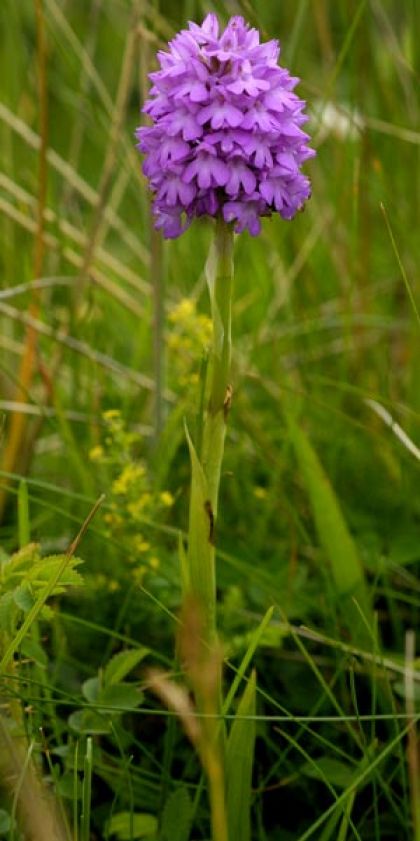From June to August, this little Orchid transforms a walk along grassy coastal paths and through open woodland into a real joy. It's quite a variable perennial, bearing sometimes several stems, sometimes just one, usually reaching up to about 30cm high. The magenta or pink flowers appear in June and until September they are borne in dense conical heads, pyramidal shaped at first but lengthening into cylindrical spikes of 50-100 flowers. Each individual flower (6-8mm long) has a 3-lobed lip, a long downward pointed, slightly curved spur and erect hooded upper petals. The colour of the flowers fades as they age. The stem has little sheath-like leaves and the basal leaves are lanceolate. The flowers are often foxy-smelling but it is a great favourite with moths, including the Six-spot Burnet, and butterflies whose tongues can find the nectar down in the spur. This is a native plant belonging to the family Orchidaceae.
My first record of this wildflower is in 1978 near the sea at Kilcoole, Co Wicklow and I photographed it there and at Ballyteigue, Co Wexford in 2007.
If you are satisfied you have correctly identified this plant, please submit your sighting to the National Biodiversity Data Centre
Orchids have a very special manner of reproduction. Not only must their seeds find themselves on their correct soil-type, they must also receive the unwitting help of some types of fungi which live in that soil. These fungi belong to the genus Rhizoctonia and can overwhelm the Orchid seeds if they are not immediately successful in absorbing the nutrients within the fungus and continuing on to produce underground tubers. Orchids can take a long time to produce leaves, let alone flowers. The slowest is the Lady's Slipper Orchid, now sadly extremely rare, which takes from fourteen to eighteen years from seed to flower.
To learn more about our Irish orchids, I would heartily recommend a really superb book on the subject which is published by the Collins Press and entitled 'Ireland's Wild Orchids - a field guide'.
Each of our native orchids is beautifully illustrated by the gifted botanical artist, Susan Sex and is an exquisite representation of an amazing plant; Susan's illustrations are complemented by carefully-chosen words from our National Botanic Gardens orchid specialist, Brendan Sayers. Susan's illustrations of key features of our native orchids are extremely useful when trying to identify a species and Brendan's descriptions help to broaden one's understanding of this complex and intriguing subject, and lead one nearer to making a possible identification. He also contributes information on the conservation of these magnificent little plants and gives details of where they might be found. Please seek out this masterpiece from your usual bookseller or find it on Gill Books - Nature - Ireland's Wild Orchids




